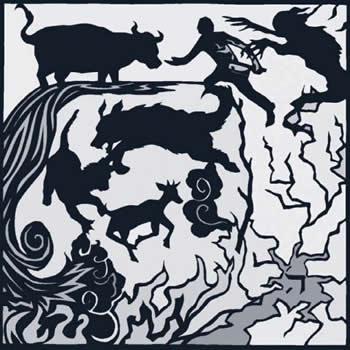Productivity, Displacement, Recursion
 The uniqueness of human language is tied to
three characteristics:
The uniqueness of human language is tied to
three characteristics:
Productivity: you can always say more.
Recursion:
Sentences that contain clauses that refer back to the sentence itself (and can do so infinitely)
Displacement: language moves in time, space
Example of Recursion: The ox came and drank the water, that extinguished the fire, that burned the stick, that beat the dog, that bit the cat, that ate the goat, which my father bought for two zuzim (follow the illustration counter-clockwise from the ox on the upper left).
Next: Can animals speak?
Additional information, not on tests: Read what's below and then come back and check out this page on displacement and non-human senses.
The image (and example of recursion) is Chad Gad-ya ["one only kid"... Chad is pronounced with a hard ch sound and rhymes with odd. It doesn't sound like the name Chad] a song from Jewish tradition that is something like "I know an old lady who swallowed a fly..." However, it dates from at least the 16th century and has strong allegorical meanings. If you're interested in learning more, click here (not required). The lyrics are too long to reprint but here are the first 3 verses and the last verse so you get the idea: One only kid, one only kid/That Father bought for two zuzim,/ one little goat, one little goat.// Then came a cat/and ate the goat,/That Father bought for two zuzim/ One only kid. One only kid.//Then came a dog/and bit the cat,/that ate the goat,/That Father bought for two zuzim/One only kid. One only kid./////Then came the Holy One, Blessed be He/and slew the the Angel of Death,/that killed the slaughterer,/that slaughtered the ox,/that drank the water,/that quenched the fire,/that burnt the stick,/that beat the dog,/that bit the cat,/that ate the goat,/That Father bought for two zuzim,/One only kid. One only kid.]
Moving out of the traditional religious sphere, I offer the following somewhat well known examples:
First, a dictionary definition: Recursion (ri-kur'zhen) See recursion.
Or, better, if you're old enough to remember Sherry Lewis and Lamb Chop and "The Song that Doesn't End," that's a perfect example. If you don't recall it, you can see it here (just watch the first couple of minutes, but note that the video has more than 4 million views!).
Or, if you want a somewhat more intellectual example, consider a parody of a famous novel opening:
It was a dark and stormy night, and we said to the captain, "Tell us a story!" And this is the story the captain told: "It was a dark and stormy night, and we said to the captain, "Tell us a story!" And this is the story the captain told: "It was a dark..."
Or super-intellectual, John Barth's story "Frame Tale" On the opening pages of his 1968 novel Lost in the Funhouse Barth provides two pages. On one is written "Once Upon A Time There" and on the other "Was a Story that Began." Barth instructs you to cut the words out in two strips and then tape them together so they form a mobius strip. You then truly have a never ending story.
Now, these are (I think) fun examples because they demonstrate logical flaws or paradoxes that are built into the nature of language itself. The example are all English, of course, but you could do something similar with any language. The critical point is that the recursive structures that produce the paradoxes above are the same ones that produce normal utterances. A user on "Stack Exchange" gives the example: Alex has a red car -> Alex, who you know very well, has a red car -> Alex, who you know very well, has a red car which is parked there... With each additional phrase, we are referring back to Alex in a kind of nested bowl phenomenon. Just like The Song that Doesn't End," our sentence could logically go on forever (but would get too confusing after a certain point).]
 The uniqueness of human language is tied to
three characteristics:
The uniqueness of human language is tied to
three characteristics: